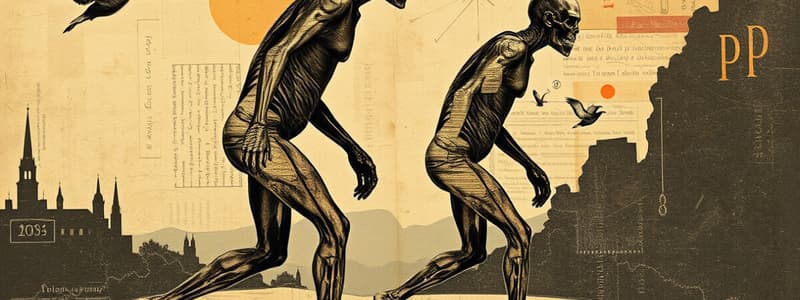Podcast
Questions and Answers
What is the concept of Finalism in human evolution, and why is it considered false?
What is the concept of Finalism in human evolution, and why is it considered false?
Finalism suggests human evolution has a specific end goal, portraying other hominids as failed attempts at being human. This is false because every species serves a unique purpose on Earth.
Describe the significance of bipedalism in the evolution of hominins.
Describe the significance of bipedalism in the evolution of hominins.
Bipedalism allowed our hominid ancestors to walk on two feet, marking a crucial milestone in their evolution approximately 6 million years ago. It enabled them to adapt to their environment more efficiently.
What does the term Presentism imply in the context of human evolution, and what is its limitation?
What does the term Presentism imply in the context of human evolution, and what is its limitation?
Presentism implies that focusing solely on the present excludes the relevance of our past. Its limitation lies in disregarding how knowledge of our ancestors informs our understanding of human development.
What marked the beginning of Material Culture in human evolution, and why is it important?
What marked the beginning of Material Culture in human evolution, and why is it important?
Explain the Three Age System and its relevance to understanding Prehistory.
Explain the Three Age System and its relevance to understanding Prehistory.
What characterized the Paleolithic Era in terms of lifestyle and tool use?
What characterized the Paleolithic Era in terms of lifestyle and tool use?
How did the transition from hunting-gathering to farming occur according to new narratives?
How did the transition from hunting-gathering to farming occur according to new narratives?
What is meant by the term 'dichotomous' in relation to farming and foraging?
What is meant by the term 'dichotomous' in relation to farming and foraging?
Describe the role of the Holocene in the context of human subsistence strategies.
Describe the role of the Holocene in the context of human subsistence strategies.
What impact did the Agricultural Revolution have on human populations?
What impact did the Agricultural Revolution have on human populations?
Flashcards are hidden until you start studying
Study Notes
Myths about Human Evolution
- Finalism: Misconception that evolution has an end goal; all species serve their unique purpose rather than being failed attempts at humanity.
- Human Exceptionalism: Incorrect belief that humans are more special than other species; every species has its own value in the ecosystem.
- Presentism: The notion that only the present matters; understanding our ancestors is crucial for a comprehensive view of evolution.
Six Big Events in Human Evolution
- Bipedalism: Emerged around 6 million years ago, marking the transition of ancestors from hominids to hominins through the ability to walk on two feet.
- Nonhoning Chewing: Occurred approximately 5.5 million years ago with the reduction of honing canine teeth, enabling a different chewing mechanism.
- Material Culture and Tools: Development began 3.3 million years ago, signifying the use of tools and materials to adapt to environmental needs; complex practices included stone tools.
- Hyoid Bone Development: Around 2.5 million years ago, the evolution of this bone allowed for speech and improved communication.
- Hunting: Initiated about 1 million years ago, emphasizing meat as a key protein source for human diets.
- Domestication: Began 11,000 years ago, indicating the control and cultivation of animals and plants for human benefit.
Prehistory
- Defined as the era without written records, characterized by the existence of societies evidenced by artifacts and physical remains.
- Civilizations can be recognized through material evidence, pre-dating written documentation.
The Three Age System
- Classification: Divides Prehistory into the Stone Age, Bronze Age, and Iron Age based on predominant tools and materials used.
- Iron Age: Not necessarily limited to iron tools; marked by the onset of iron usage.
Stone Age
- Paleolithic Era: Characterized by nomadic lifestyles, reliance on hunting and gathering, use of rough stone tools, and the discovery of fire.
- Mesolithic Era: A transitional phase leading to settled agriculture, showing changes in subsistence strategies.
- Neolithic Era: Marked by settled communities, domestication of plants and animals, polished stone tools, and emerging trade practices.
Old Narratives of Farming
- Viewed farming as a universal shift occurring simultaneously across the globe, with individuals categorized strictly as either farmers or foragers.
- The so-called "Agricultural Revolution" represented a rapid transition, laying the groundwork for civilization.
New Narratives of Farming
- Diverse Timing: Domestication happened at varying times and locations, disproving the idea of a synchronous global shift due to communication limitations.
- Mixed Lifestyles: Individuals could engage in both farming and foraging depending on their circumstances and needs.
- Gradual Transition: Shifts from foraging to farming occurred over time and were not linear.
- Population Growth: While farming facilitated growth by providing food access, it did not inherently force population increases.
The Holocene
- Foraging dominated human existence for much of history; many contemporary societies still rely on these subsistence strategies.
- There exists a wealth of evidence showing the coexistence of foraging and farming throughout the Holocene era.
Studying That Suits You
Use AI to generate personalized quizzes and flashcards to suit your learning preferences.




